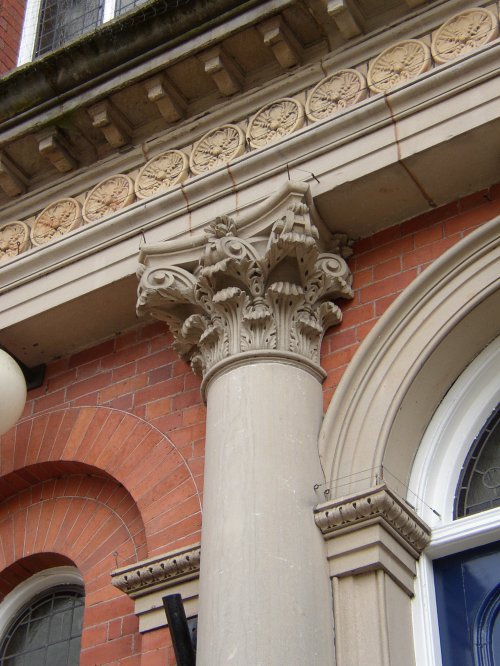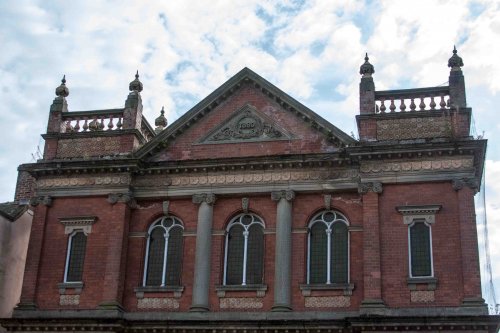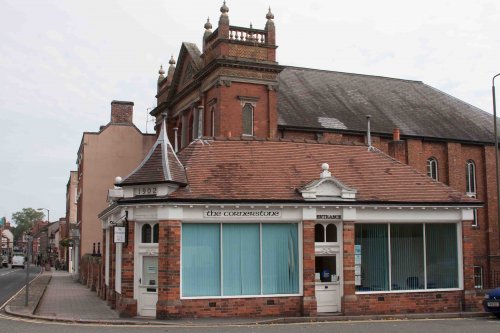The Chapel replaced 3 houses, which had previously been owned by a family of skinners, with their skinyard by the river to the rear of the property.
The Methodist Chapel was built between 1879 and 1881 and replaced an earlier chapel, built in 1822, in Compton. The chapel has a distinctive Italianate front decorated with terracotta panels and friezes. When the Chapel was built the neighbouring Station Road did not exist and Church Street had an unbroken line of houses. The Chapel replaced 3 houses, which had previously been owned by a family of skinners, with their skinyard by the river to the rear of the property.
The Chapel would have stood out amongst the Georgian properties in Church Street, and was intended to look very different from the local Gothic Anglican Churches. Not everyone appreciated this design: the architectural historian Nikolaus Pevsner described the Church as a “pretentious eyesore” in the first edition of the Derbyshire volume of his "The Buildings of England". The 2nd edition revised this opinion to merely “pretentious”. When the railway was extended from Ashbourne to Buxton in 1899, more Georgian properties were demolished to make way for the railway line and Ashbourne’s first new road since medieval times, Station Road, was created. The Methodist Chapel was extended to provide some lock-up shops (now The Cornerstone café) and a Church Hall (Century Hall).
The Chapel has an Italianate neo-classical façade. This style had become popular in the 1850 and 60s after Queen Victoria’s Osborne House, on the Isle of Wight, was built in this style; it was becoming somewhat dated when the Chapel was opened in 1881 as the ”New Wesleyan Chapel”. The façade is brick with ashlar sandstone dressings and terracotta ornaments. The imposing central steps lead to panelled double doors and a fan light with roundels with Corinthian columns on either side. The effect is to lift your eye into the building. The corner towers have pilasters (flat columns built out from the wall) and are topped with terracotta-panelled parapet surmounted by balustrades.
On the first floor, there are Ionic ½ columns between round arched windows and a central pediment with a dated triangular panel. Inside, the Chapel reflects the non-conformists’ approach to religious services: the emphasis is on seeing and hearing the Minister. There is no central aisle and the seating and gallery are arranged to give a clear view of the preacher. The organ pipes are in a coved recess under an arch on Corinthian columns with round arched doors to either side. The roof is supported on carved corbels (projecting supports), and the tie rods incorporate scroll work.
Before the railway was extended from Ashbourne to Buxton in 1899, Church Street was a continuous line of buildings from the town centre to School Lane by St Oswald’s Church. However, to make way for the railway, 3 properties next to the Methodist Church had to be demolished; and Ashbourne’s first new road since medieval times, Station Road, was created. In 1902, the Methodists took this opportunity to extend their Chapel to provide some lock-up shops (now The Cornerstone café) – an early example of social enterprise - and a Church Hall (Century Hall).
Both buildings are in an eclectic Art Nouveau style which, in 1902, was at the forefront of fashion. The buildings are in definite contrast to the neighbouring Georgian properties and the somewhat dated neo-classical design of the chapel only built some 20 years earlier. They are on the site of a pair of charity schools for 30 poor girls and 30 poor boys built in 1713-14 under the will of a local businessman. The boys were given a basic academic education to enable them to enter the Grammar School, but the girls were taught only reading, sewing and knitting.
In WW1, Century Hall was used as an auxiliary hospital for injured servicemen. Later, the corner building was the Town's Driving Test Centre, and people came from miles around to take advantage of a test in the Town's benign traffic conditions.
First brought Methodism to Ashbourne in 1754
The Ashbourne Methodist Society was officially formed in April 1755, when John Wesley stopped at Ashbourne and preached to a "deeply serious congregation".
Catherine Booth was wife of General William Booth and co-founder of the Salvation Army. She was born at 13 Sturston Lane (now Road), Ashbourne in 1829. There is a bust to her in Ashbourne Park.
The Ashbourne Methodist Society was officially formed in April 1755.
















